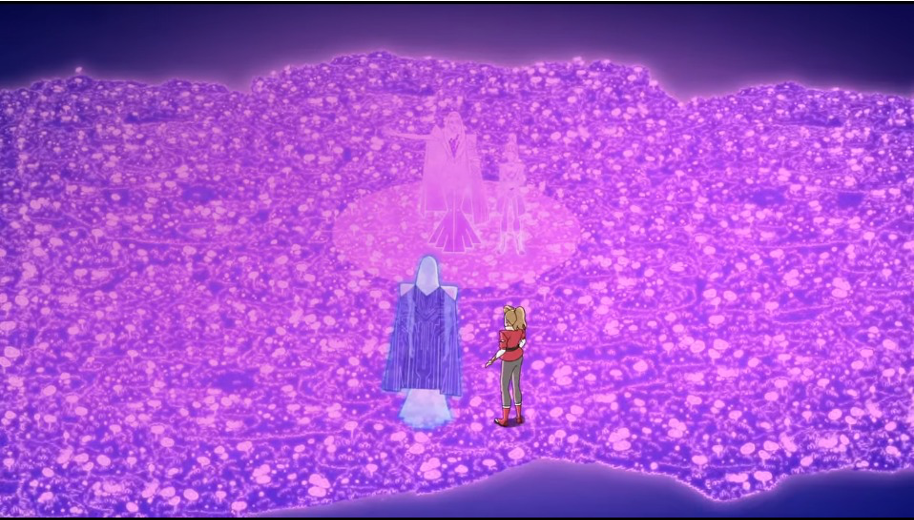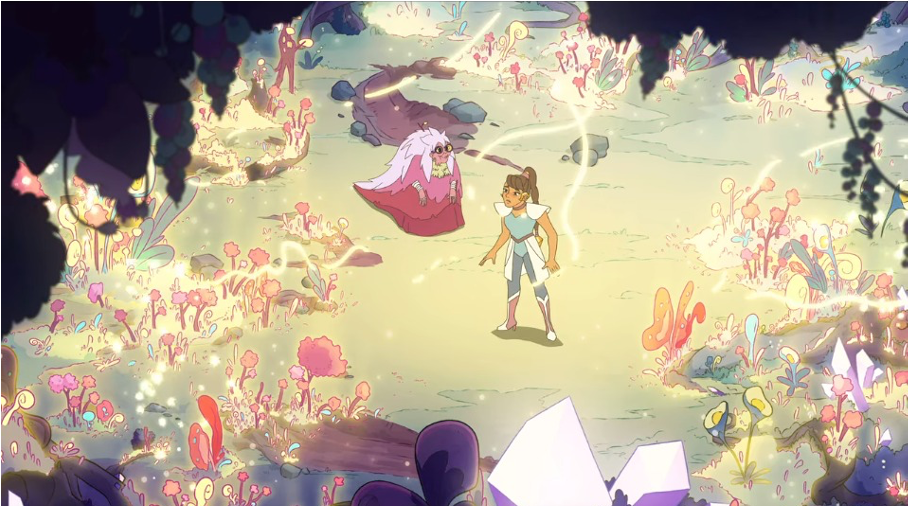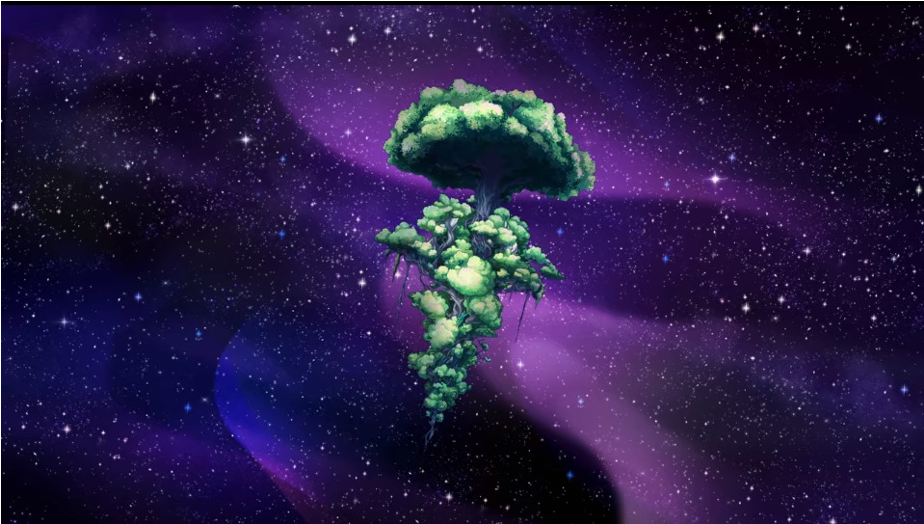In his introduction to Eco-Trauma Cinema, Anil Narine states that “nature, whether it threatens us, we threaten it or we see ourselves as part of it, remains sublime” and resistant to any meaning we try to make out of it (2015: 1). However, within the sphere of western children’s animation, with its limited 2D shapes and color palettes, connections can be formed unburdened by nature’s reality as a force disconnected from our emotional perceptions of it. In She-Ra and the Princesses of Power (2018-2020), the immensity of the environment becomes a conduit for the characters’ emotional states. All the Princesses within the show are connected to Etheria’s environment through their runestone. However, it is She-Ra, embodied by Adora (Aimee Carrero), who shows a clear parallel to the control and release of Etheria’s environment in her own recovery from trauma.

Eco-trauma can be defined by when “we treat ecological harm as a trauma: something acknowledgeable that we work to repress in order to avoid its painful effects” (Narine, 2015: 2). While this is usually an instinctual move on the part of the brain to protect itself, Adora’s repression is an external one, illustrating a form of control instigated by the mysterious First Ones, who also attempt to control Etheria by turning it into a weapon. Yet, it is through Etheria that Adora can begin to re-access the memories of her predecessor Mara (Zehra Fazal). In S4E5 “Protocol”, Adora accesses a memory of Mara bringing Etherian flowers to the AI Light Hope (Morla Gorrondona), who makes the flowers spread (Figure 1). Even as just a holographic memory, the flowers link Light Hope’s own emotional response to Mara and hint towards the trauma revealed at the end of the episode of her self-imposed memory wipe that bears more than a passing resemblance to the idea of trauma as “memory shifted to another part of consciousness mainly accessible in the … traumatic phenomena of flashbacks, phobias, and dreams” (Kaplan, 2005: 73-4). It is a trauma passed on to Adora who must construct She-Ra’s memories and function. In a later episode in the same season, S4E9 “Hero”, the reveal of She-Ra as a force born of the powers of Etheria rather than a technological construction lends credence to the idea that the connection of Adora and Mara’s memories is one tangled up with the environment of the planet. As Mara has this realization, the plants begin to glow and light embraces her, while Razz (Grey Griffin) – the wizened figure of the Whispering Woods – states: “You cannot control magic, magic simply is” (Figure 2). This statement draws attention to how in much the same way Etheria’s environment remains uncontrollable, Mara, Adora, and even Light Hope go on to defy the ways they have been controlled as part of the First Ones’ weapon.

Commonly, “emotions have been perceived as occurring predominantly at the level of individual experience, they have been dismissed as a disturbance” (Harding and Pribram, 2004: 871). Also, their repression for the sake of order is not generally considered a trauma. However, the same control one may try to exert over the environment and its returning trauma would surely have a similar impact on people. And within the show, there are repeated encouragements, often on Light Hope’s side, for Adora to let go of earthly emotions and connections to better integrate with She-Ra. Often juxtaposed with statements over Mara being ‘unhinged’ and a destructive force for Etheria. Once this is revealed as untrue, the trauma of this lie can be unpacked. It is no jump to link Adora and Mara’s emotional states, heightened by the uncontrollable nature of Etheria with which they are connected to by the narrative, to the fact “being ‘more emotional’ is most often equated with being less in control of feelings in a pejorative or problematic way and has served as justification for women’s exclusion from any number of corridors of power” (Harding and Pribram, 2004: 881). This is reinforced by creator Noelle Stevenson confirming Mara’s misleading characterization via Light Hope as a reference to women who preceded her in the animation industry and had their own, wrongly attributed, bad reputations. While Mara sacrifices her life to save Etheria to overcome the trauma of the First Ones’ actions both on her and Etheria and the finale suggesting Adora is willing to do the same, the path Adora eventually does take turns away from Mara’s isolation. In what is reflective of the show’s thesis on the power of emotional closeness, the resolution to eco-trauma is not disconnection but a full embrace of the environment’s immensity.

Understanding eco-trauma within the show can then be seen as a way to move towards an understanding of the interconnectedness of emotional states via an environment characterized as more responsive than our own. Recovery from this trauma becomes a full embrace of emotion rather than a distancing from it. In the final episode, S5E13 “Heart Part 2”, Catra (AJ Michalka) and Adora’s love saves the planet. The final scenes show nature covering Etheria and overpowering Hordak Prime’s (Keston John) ship (Figure 3). There is no control or direction to the action which is “too vast in its beauty and power to comprehend” (Narine, 2015: 1), the same as She-Ra herself now unchained from a control based on the lies of emotional disconnection from both each other and the environment.
References
Harding, J. and Pribram E. D., (2004). “Losing Our Cool? Following Williams and Grossberg on Emotions”, Cultural Studies 18(6), pp. 863-883.
Kaplan, E. A., (2005). Trauma Culture: The Politics of Terror and Loss in Media and Literature. New Brunswick: Rutgers University Press.
Narine, A., (2015). Eco-Trauma Cinema. New York: Routledge.
Isabella Macleod is a recent MA graduate from King’s College London, where she graduated with a dissertation on representations of traumatized motherhood in the films of Clio Barnard. Her previous articles include an editorial on animation studio Laika for fantasy-animation.org, a guide to the concept of ‘queerbaiting’ and an editorial on Transformers: Age of Extinction, both for mcc.sllf.qmul.ac.uk. She also has a forthcoming chapter on ‘self-insert’ fan fictions in Culture: raise ‘Low’, Rethink ‘High’. An Exploration of the Academic Potential of So-called Low Culture (2020).

2 comments for “(Environ)Mental Trauma and Recovery in “She-Ra and the Princesses of Power””